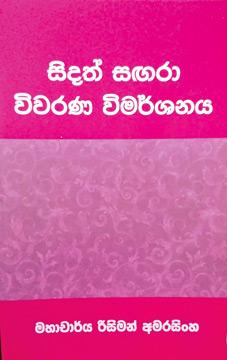
‘Sidath Sangara Vivarana Vimarshanaya’
Author: Prof. Risiman Amarasinghe
Godage Publishers, Colombo 10
144 pages
Price: Rs 350
At the outset, I would like to quote some epigrams from the celebrated English author and critic Sir Francis Bacon:
“Some books are to be tasted,
Others to be swallowed,
And some few to be chewed and digested;
Crafty men condemn studies,
Average men admire them,
And wise men use them.”
From the point of view of an average man, I admire works of great writers like Prof. Risiman Amarasinghe. His latest work, ‘Sidath Sangara Vivarana Vimarshanaya’ falls into the third category of books as clarified above, that is, “some few to be chewed and digested.”
My first impression is that it is a reference book for constant use among scholars and one to be consulted occasionally by ordinary readers. I say so because advanced grammar is not very popular among moderate people. It is suitable for use in the higher echelons of the teaching profession. I still remember how my class teacher of Standard Five started to explain verses in ‘Subhasitaya’ asking us the typical question after reciting a verse: What is the ‘kriyakarakapadasambandaya’ of this quatrain? (What is the agreement of subject with the verb or syntax?) ‘Sidath Sangara’ is a synopsis of Sinhala grammar.
I had a copy of ‘Sidath Sangara’ printed and published in 1900 by D.D. Seneviratne, used by my father in the early 1920s. Although it never appealed to me, I kept it safely in my library. After a long time, I came upon another copy of ‘Sidath Sangara’ edited by Ven. Dr Batuwantudawe Sri Devarakshitha. It occurred to me when I read it that Sinhala grammar is influenced by that of Pali which is said to be older than Sanskrit. Moreover, Sanskrit has a dual number meant for two people or things. It has a corresponding conjugation of verbs too.
For example, the declension of nouns in the nine cases, viz. Nominative Case, Accusative or Objective Case, Aablative of Agent, Dative Case, Ablative of Instrument, Ablative of Separation, Possessive of Genitive, Locative and Vocative can be cited.
It is said in Prof. T.B. Kangaha Arachchi’s ‘Sinhala Sarala Viyaranaya’ (Simple Grammar of Sinhala) that books such as Siyabaslakara, Muvadevdavatha, Sasadavatha and Kaw Silumina had been written before ‘Sidath Sangara’ came into being in the Dambadeni era, i.e, the 13th century. That means such books may have been inspired by Pali and Sanskrit grammar systems. I hold that, with a fair knowledge of Pali, we can understand Sinhala grammar better.
Prof. T.B. Kangaha Arachchi states that ‘Sidatha’ is an outline of grammar for ‘Elu Basa,’ i.e. pure Sinhala which was used for Sinhala poetry. Aspirated characters and long vowels are rarely used in pure Sinhala. From the era before Christ up to 8th century A.D. cave paintings and rock inscriptions had used ‘Elu Basa.’ There are, however, aspirated characters too at random.
Prof. Emeritus M.W. Wimal Wijeratne comments in his review of ‘Sidath Sangara Vivarana Vimarshanaya’ it is high time that Prof. Amarasinghe published a research paper or treatise on the influence of Pali Moggalyana Grammar on ‘Sidath Sangara.’
What interested me greatly is that the subject of the Conditional Verb stands in the Accusative Case meaning the Nominative Case and Conditional Verb of Time appears in the Accusative Case representing the Locative Case.
The eighth review touches on modern views concerning the Future Tense verb of Sinhala. There he affirms that Prof. Amarasinghe and the writer agree with Kumaratunga Munidasa’s opinion that in ancient times there had been a future tense form of the Sinhala verb. It has, however, disappeared mingled with the Present Tense form. But the Pali form of future tense still exists. It is natural, however, that there are changes in living languages whereas dead languages like Pali are static.
Prof. Wimal Wijeratne remarks further that Prof. Amarasinghe has discovered for the first time that the indeclinable particle, ‘in’ is in use even today, for example, in the ‘Rantambe area’ to mean ‘a trice.’
Prof Risiman Amarasinghe is a rare intellectual who takes delight in researches. He elucidates the meaning of “Vaharanaserensapaya” in ‘Sidath Sangara.’ This term has so far been interpreted to be taken in the light of use, vogue or current fashion.
But Prof. Amarasinghe’s elucidation is quite contrary to that view. His belief is that if there is a moot point, it should be logically argued in debate with veterans in that field and then come to a conclusion. This illustration is a clear, trustworthy and unbiased analysis.
In order to support Prof. Amarasinghe’s innovative idea, Prof. Wijeratne quotes from the ‘Mahavamsa’ XXXVI, 41.
That is when the influence of Mahayana followers was tremendously harmful King Voharika Tissa got his minister Kapila to settle the issue, to establish whether the real Buddhist doctrine was Mahayana Vaithulyavada or not. Thereby through dialogue and debate it was possible to clear the wrong notion of Mahayana teachings. That is how King Tissa came to be called Voharika Tissa.
